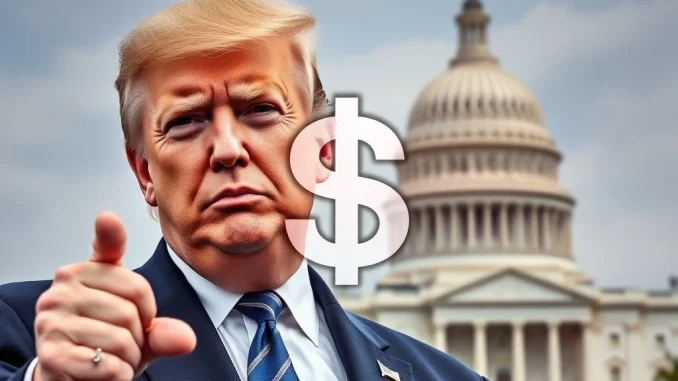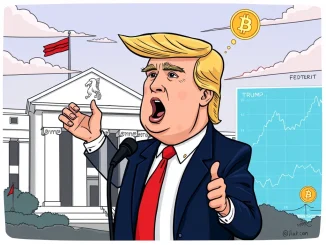
The cryptocurrency world is abuzz once again as former U.S. President Donald Trump has unequivocally reaffirmed his commitment to blocking the creation of a US CBDC (Central Bank Digital Currency) should he return to office. This declaration, initially shared by Walter Bloomberg on X, sends a clear signal to both digital currency proponents and skeptics alike, shaping the ongoing debate around the future of money in America.
Understanding the Debate: What is a Central Bank Digital Currency?
Before diving into the implications of Trump CBDC opposition, it’s crucial to understand what a Central Bank Digital Currency actually is. Imagine a digital form of a country’s fiat currency, issued and backed by its central bank. Unlike cryptocurrencies like Bitcoin, which are decentralized, a CBDC would be centralized, essentially a digital version of cash, directly controlled by the government.
Here’s a quick breakdown of common characteristics and proposed uses:
- Direct Liability: CBDCs would be direct liabilities of the central bank, similar to physical banknotes.
- Programmability: Some proposals suggest CBDCs could be ‘programmable,’ meaning their use could be restricted or time-limited.
- Privacy Concerns: Transactions could potentially be traced by the government, raising significant privacy questions.
- Financial Inclusion: Proponents argue it could help bring unbanked populations into the financial system.
- Payment Efficiency: Could streamline domestic and international payments, making them faster and cheaper.
Why the Strong Opposition to a Digital Dollar?
Donald Trump’s stance against a Digital Dollar is not new, but his repeated reaffirmation underscores a deeply held conviction that resonates with a segment of the American populace. His primary arguments often center on individual liberty, privacy, and the potential for government overreach.
Key reasons for his opposition typically include:
- Erosion of Privacy: A CBDC could allow the government to monitor every transaction, creating a surveillance state.
- Government Control: Concerns that a CBDC could give the government unprecedented power over citizens’ finances, including the ability to freeze accounts or limit spending.
- No Cash Alternative: Fear that a CBDC could eventually replace physical cash, removing a crucial layer of financial anonymity and freedom.
- Authoritarian Potential: The idea that a programmable digital currency could be used to enforce social or political agendas.
This perspective contrasts sharply with those who see a CBDC as a necessary evolution for modern finance, offering benefits like enhanced payment systems and greater financial stability. However, the privacy implications remain a significant hurdle for many, including the former President.
How Does This Impact Cryptocurrency Policy and the Broader Crypto Market?
Trump’s firm position against a US CBDC has significant implications for the broader Cryptocurrency Policy landscape. While he opposes a centralized digital currency, his administration generally took a less aggressive stance on decentralized cryptocurrencies compared to some other global leaders.
Here’s what his reaffirmed opposition could mean:
- Boost for Decentralized Crypto: A clear ‘no’ to a CBDC could indirectly strengthen the appeal of decentralized cryptocurrencies like Bitcoin and Ethereum, as they offer an alternative to centralized financial systems.
- Stablecoin Development: It might encourage the development and adoption of private stablecoins, which are often seen as a middle ground between traditional fiat and volatile cryptocurrencies.
- Regulatory Focus Shift: Without the immediate need to develop and implement a CBDC, regulatory efforts might shift more towards oversight of existing cryptocurrencies, exchanges, and DeFi protocols.
- Innovation Landscape: American innovation in the crypto space might continue to flourish without the looming shadow of a government-controlled digital currency.
It’s important to note that while a president’s stance is influential, the actual implementation of financial policy involves Congress, the Federal Reserve, and other regulatory bodies. However, a clear executive directive can certainly set the tone and direction for future discussions.
The Global Context: Where Do Other Nations Stand on CBDCs?
While the debate rages in the U.S. over a Central Bank Digital Currency, many other nations are at various stages of exploring, piloting, or even launching their own CBDCs. This global trend highlights the complexity and varied approaches to digitalizing national currencies.
Consider these examples:
- China (Digital Yuan): China has been a frontrunner, extensively piloting its digital yuan (e-CNY) with millions of users and transactions. Their approach emphasizes control and traceability.
- Europe (Digital Euro): The European Central Bank is actively exploring a digital euro, focusing on privacy, financial stability, and efficiency. They are currently in an investigation phase.
- Bahamas (Sand Dollar): The Bahamas was one of the first countries to fully launch a CBDC, the Sand Dollar, aiming to improve financial inclusion across its dispersed islands.
- India (Digital Rupee): India has launched pilot programs for both wholesale and retail versions of its digital rupee.
The U.S. remains cautious, with the Federal Reserve publishing research papers and engaging in public discourse, but without committing to a definitive path. Trump’s opposition adds another layer of political complexity to this cautious approach, potentially cementing the U.S. as an outlier in the global CBDC race.
What’s Next for the Digital Dollar and Crypto Policy?
The future of the Digital Dollar and broader Cryptocurrency Policy in the U.S. remains a dynamic and evolving landscape. Donald Trump’s reaffirmed opposition to a CBDC signals a potential continued resistance to a centralized digital currency, should he be re-elected. This could mean a more favorable environment for private digital assets and stablecoins, as the focus shifts away from a government-issued alternative.
However, the global push for CBDCs and the ongoing innovation in blockchain technology mean that the conversation around digital money is far from over. The crypto community will be watching closely to see how these political stances translate into concrete policies and what impact they will have on the future of finance.
Conclusion: A Clear Line in the Digital Sand
Donald Trump’s unambiguous stance against a US CBDC draws a clear line in the digital sand, positioning him as a strong advocate for financial privacy and individual liberty in the digital age. This perspective, while controversial to some, resonates deeply with those wary of increased government surveillance and control over personal finances. His opposition may well serve as a bulwark against the rapid adoption of a centralized Digital Dollar, potentially clearing the path for decentralized cryptocurrencies and private stablecoins to thrive in the American market. As the debate continues, one thing is certain: the future of money in the United States will remain a hotly contested and pivotal issue for years to come.



